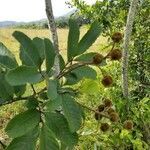Tree 5-15 m tall; stems ferruginous-tomentose, glabrescent, conspicuously lenticellate. Leaves paripinnate or imparipinnate; petiole plus rachis 7-12 cm long, tomentulose; leaflets 2-4 pairs, alternate or subopposite, coriaceous to chartaceous, adaxially glabrous, abaxially ferruginous-tomentose or tomentulose, with prominent network of veins, obovate to oblanceolate, 5-15 × 2.5-7 cm (basal leaflets smaller than distal ones), the apex obtuse or retuse, the base obtuse, slightly unequal, the margins serrate, revolute. Thyrses axillary, 15-20 cm long, paniculate; axes densely ferruginous-tomentose; bracts subulate, tomentose, ca. 2.5 mm long; flowers in compound or simple dichasia. Sepals narrowly ovate, ca. 3.5 mm long, ferruginous-tomentose; petals white, rhombate, clawed, tomentulose, with 2 marginal appendages; disc cupular, pubescent; filaments tomentose at base. Capsule trigonous-depressed-globose to turbinate, 3-locular, 1-1.5 cm long, shortly stipitate, pericarp woody, ca. 5 mm thick, outer surface densely ferruginous-sericeous, inner surface densely creamish lanose. Seeds ellipsoid, ca. 1 cm long, blackish or dark brown, with an orangish fleshy coat on lower half.
More
A small tree. It can be 20 m high. The leaves are compound with 2-4 pairs of leaflets. The flower panicles are 10-30 cm long. The fruit is a shallowly 3 lobed capsule. It is 2 cm long by 2 cm wide. It has yellow hairs. The seed is oval and 1 cm long. It is black and shiny. It has an aril of fleshy layer around it.
Forests, especially along streams, in the moist coast, moist limestone, and lower mountain regions of Puerto Rico.
More
A tropical plant. It grows in forests near rivers.


